Kingdom Animalia #3 - The bowerbirds
And Today on the Kingdom Animalla series I decided to do something on the birds, when the idea came I had the Flame and The Regent bowerbird in mind (as their colouration stunned me, though not compared to what I felt when i see the birds of paradise ) but I was like, why not do something on the bowerbird specie, and here I am with the powerbirds.
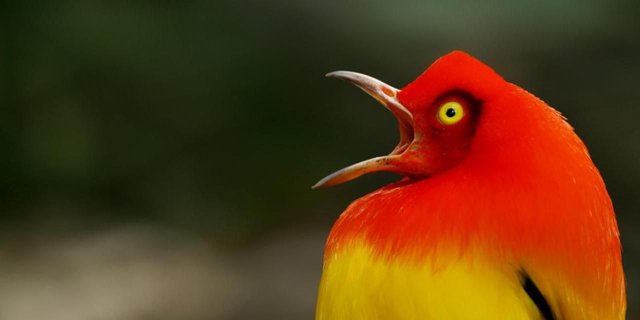
Though there are about 20 (or more) members of the bowerbird specie, I will be introducing some cool members and their surprising courtship behaviour. Do you know the male bowerbirds go as far as dancing to impress its female? Stick with me guys in the building, you might learn a thing or two about impressing a lady
Selected Members Of The Bowerbird Family And Their Courtship Displays
The Regent Bower Bird
A common specie of the powerbirds is the Regent bowerbird. The Regent bowerbird is known to be a serially dimorphic bird, and they are medium size with their length up to about 21–35 cm in length, with the females being slightly smaller. They are mainly olive brown in colour, though somewhat paler below, with no ornamental plumage. This makes the species one of the dullest-coloured members of the bowerbird family with, however, one of the largest and most elaborate bowers.
The male Regent bowerbird has more of the black colouration with crown colour ranging from yellow to a golden orange colour. Their bill colour is known to be yellow with their feet black and iris colour yellow.The female Regent bowerbird on the other hand is brown in colour and consist of fawn marking whitish in colour, they have bill colour, Grey and their feet and crown have a black colouration.
Courtship Behaviours
The male Regent bowerbird just like just like some other bowerbirds build bowers to attract females, this bower can be in the form of a ground clearing cheetah, and they can also be in the form of elaborate structure. They have been noticed to build a bower which is in the form of an Avenue; it normally consists of walls of the stick, two in number which will be decorated with seed, shells berries and leaves.
Ernest Thomas Gilliard suggested the transfer effect, in which he claimed that there is an inverse relationship between bower complexity and the brightness of plumage. Gilliard suggests that there is an evolutionary "transfer" of ornamentation in some species, from their plumage to their bowers, in order to reduce the visibility of the male and thereby its vulnerability to predation. This hypothesis is not well supported because species with vastly different bower types have similar plumage. Others have suggested that the bower functioned initially as a device that benefits females by protecting them from forced copulations and thus giving them enhanced opportunity to choose males and benefits males by enhancing female willingness to visit the bower. Evidence supporting this hypothesis comes from observations of Archbold's bowerbirds that have no true bower and have greatly modified their courtship so that the male is limited in his ability to mount the female without her cooperation. In toothbilled bowerbirds that have no bowers, males may capture females out of the air and forcibly copulate with them. Once this initial function was established, bowers were then co-opted by females for other functions such as use in assessing males based on the quality of bower construction. Recent studies with robot female bowerbirds by Patricelli and collaborators have shown that males react to female signals of discomfort during courtship by reducing the intensity of their potentially threatening courtship.[citation needed] Coleman and colleagues[citation needed] found that young females tend to be more easily threatened by intense male courtship, and these females tend to choose males based on traits not dependent on male courtship intensity.
The high degree of effort directed at mate choice by females and the large skews in mating success directed at males with quality displays suggests that females gain important benefits from mate choice. Since males have no role in parental care and give nothing to females except sperm, it is suggested that females gain genetic benefits from their mate choice. However this has not been established, in part because of the difficulty of following offspring performance since males take seven years to reach sexual maturity. One hypothesis for the evolutionary causation of the bowerbuilding display is Hamilton and Zuk's "bright bird" hypothesis, which states that sexual ornaments are indicators of general health and heritable disease resistance. Doucet and Montgomerie determined that the male bowerbird's plumage reflectance indicates internal parasitic infection, whereas the bower quality is a measure of external parasitic infection. This would suggest that the bowerbird mating display evolved due to parasite mediated sexual selection, though there is some controversy surrounding this conclusion.
This complex mating behaviour, with its highly valued types and colors of decorations, has led some researchers[citation needed] to regard the bowerbirds as among the most behaviorally complex species of bird. It also provides some of the most compelling evidence that the extended phenotype of a species can play a role in sexual selection and indeed act as a powerful mechanism to shape its evolution, as seems to be the case for humans. Inspired by their seemingly extreme courtship rituals, Charles Darwin discussed both bowerbirds and birds-of-paradise in his writings
In addition, many species of bowerbird are superb vocal mimics. MacGregor's bowerbird, for example, has been observed imitating pigs, waterfalls, and human chatter. Satin bowerbirds commonly mimic other local species as part of their courtship display.
Bowerbirds have also been observed creating optical illusions in their bowers to appeal to mates. They arrange objects in the bower's court area from smallest to largest, creating a forced perspective which holds the attention of the female for longer. Males with objects arranged in a way that have a strong optical illusion are likely to have higher mating success.

Male Regent bowerbird in bower
They have been noticed to sometime use green leaves to spread substance just like making use of a paint brush; this is known to be one of few use of the tool by a bird. Females often build a nest which is made of twigs in the form of a saucer shape they measure about 15 to 20 centimetre wide and height of about 30cm.
Flame Bowerbird
The flame bowerbird is of two species, one from the southwest of New Guinea which has an orange face for the male and the other black throat and face known as the black-faced bowerbird.
The male flame powerbird has its nape, crown and it's mantle of a glossy flame colour. It's chin and throat have a black colouration and also on the side of its neck. They have their upper tail colour to be black having a fine yellow edge and their underparts are yellow which is a bit paler than its upper part.
Their iriis are coloured bright yello, and they have bill colour to be pale Grey with blackish legs.
The female flame power is of a similar size to the male with the exception of its tail as a male have theirs longer than the females with plumage different. Their iris is dark brown, and they are known for a bit darker feather. They have their top side olive brown which gets redder towards the head.
Courtship Behavoir
The male flame bowerbird on a seasonal based builds a decorated bower in an Avenue form which is constructed neatly with thick sticks at the outer part of the base and fine ones within the bower. Their decoration colours include brown fruits, purple, blue, white flowers, leaves, blackish leaves and snail shell.
When a female appears and is sighted by the male, he begins to dance to impress her; this dance goes with it making himself small then bigger by in a way pumping himself, this effect is shown the more when spreads wings during the pumping. Have you done this dance to impress her.
This dance pattern is believed to be a from of signal for the female inspect its bower, and when it's noticed she did, the male intensify it's dancing, and they touch their bills when they are both at his bower.
Satin Bowerbird
The satine bowerbird is another beautiful powerbird to behold, it's male have an eye colour, violet-blue, and they have a uniform black colour of black, but their feather texture gives a look which is almost shiny metallic with a blue nature.
The female satin bowerbird has almost looked like the spotted catbird or the green catbird having a brown /green or an entire brown part of the upper part of its body and had it's under part of a lighter colouration with a scallop pattern, and they also have blue eyes.
They can be found mostly in the rainforest and around East Australia in the sclerophyll forest. An Isolated population also exist in North Queensland along the wet tropic.
Courtship For The Satin Bower bid
They show a complex behaviour during Courtship. The male satin bowerbird is known to build structures with sticks, that is, their bowers, and this structure is decorated with colours like yellow, blue and also objects shiny, their decorative need ranges from plastic objects, leaves, berries, clothes pegs, drinking straws, and ballpoint pen.
As they mature, they tend to use more of the blue colour than others. To choose a mate, the females visit this bower which follows by the male satin bowerbird performing an intense display called dance to woo the female
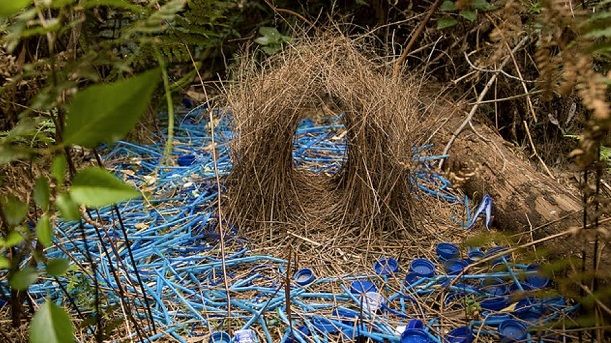
Bower of a satin bowerbird, notice the distinct colour used
The satin bowerbird is known to have the longest lifespan in the passerine order.
The Great Bowerbird
This bowerbird is native to Northern Australia from the Broome area across Cape York and far south to Mount Isa.
Their most preferred habitat is the Woodlands and forest and also the vine forests, mangrove swamp and the monsoon forest.
As a member of the bower family, they have their life cycle dominated by consideration of breeding. The female is known to nest and raise young ones alone as male spend most of the year working on their bower as only a successful bower can get him a mate.
They are known to be the largest of this family ranging from 33cm—38cm in length and colouration of fawny Grey. Their males are seen to have a pink crest on the nape.
Courtship In The Great Bowerbird
The great bowerbird builds bowers which it uses to attract its females just like most members of this family do. The bower built is the Avenue bower which is about 1 meter in length and has a height of approximately 45cm. Their bowers has been noticed to be below a shrub, and they have also been seen below a leafy branch of trees. Ends of their bower are decorated with the green and white colour which ranges from bones, leaves, stones, objects like plastic, bottle caps and sometimes shells. Sometimes inside the bower is placed with glass.

Bower of the great bowerbird
Unlike other bowerbirds, they practice building their bower at a young age where some young individuals will join to build a bower hence practising the skill to be perfect at building theirs for mating.
The Vogelkop Bowerbird
They are also called the Gardner bowerbird; probably because of the great lengths, they go with their bower. This is known to be a bird of medium size which is native to Western part of New Guinea in a place called Vogel Peninsula.
They measure approximately 21to 35 centimetres in length and have their females to be a bit smaller. Their colouration is known to be olive-brown though this colour gets paler at their underparts, this colouration is however known to be amongst the dullest colour known for the bowerbird species, but they are also known to have a large bower.
Courtship For The Vogelkop Bowerbird
They have a bower which is like a hut having the shape of a cone. It measures about 100cm with respect to height 160cm with respect to diameter and having an entrance which is made of sticks and the front of their bower are cleaned by them and placed with Moss.
Decorations are made on their bower at the bower entrance, and this decoration consists of colourful fruits or flowers, dead leaves the shinning Beetle and also some objects which are well arranged artistically around their bower.
The male Vogelkop Bowerbird ensures that they are at the prime with their display to females by trying as much as possible to create a perfect bower which will beat neighbours arranging bower more appropriately.
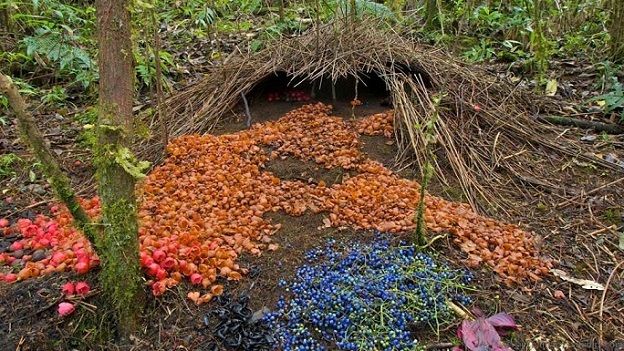
Bower of a vogelkop bowerbird
This bowerbird does not have a preference of colour thus the prime of its bower is them finding an unusual item. The female Vogelkop Bowerbird visits the males bower, and they choose their mate If they like what is being displayed.
The Green Catbird
This is another bowerbird species which are found in the subtropical forest which is along eastern of Australia, Queensland and the southern part of New South Wales. They are named after the calls they make which is more like the meowing of a cat.
They are medium size birds having long and powerful legs with stout bills. Their rump, wings and back are emerald green in colour and the feature white spots on top of tertiary. Its tail has a whitish emerald colouration having a white tip. Their head has a greenish brown colouration their chest colour ranges from greenish buff down to dull emerald having streaks with white colouration.
Their bill has a horn colour, and their legs are greyish brown in colouration with their iris bright red having an eye ring, partially white in colouration.
Males and females are similar hence it's difficult to distinguish between them. Their juvenile is also similar but a bit duller.
Courtship Display
The male catbird, unlike other bowers, do not build a bower to attract it's female, but they do it in their cool manner. The male, however, clears an area which will give him space perform his display for the female catbird. Just like others of same species, the catbird tends to attract its female counterpart by displaying colourful flowers, fruits and having a leaf at its beak.
More Members Of The Bowerbird Specie
The White-Eared Catbird
This species of the bowerbirds is normally found in islands West Papua and New Guinea. They have their natural habitat to be either the tropical or subtropical dry forests and the tropical and subtropical low lands forest
They have an upper part coloured green, and crown coloured brown with face colour, whitish. Their under part is Buffy with black spots.
Golden-Fronted Bower Bird
This bowerbird is of medium size measuring about 24cm with respect to length. They have rufous brown to be the colouration for male and with a golden crest which is of an elongated nature extend from its forehead. It's female is of olive brown colouration. They have their feet to be dark Grey and underparts yellow.
The male golden bowerbird builds towers (may pole type) which it decorates with fruits.
The MacGregor Bowerbird
This bowerbird is of a medium size measuring the about 26cm length and having colouration, olive brown. They are similar to a Robin with respect to shape and size. Male MacGregor bowerbird have an erectile crest which colours orange-yellow, and they hide this crest to display during courtship. Females are similar to males but do not have the crest.
They build bowers too which are decorated with fruits, flowers, objects and insects. When it's bower is visited by a female, it opens it's crest displaying full colour to impress her.
Archbold's Bowerbird
They are beautiful bowerbirds about 37 centimetres long having colouration dark Grey, they have a brown iris, and their male has black scalloping with crown golden yellow and it's forked tail of dark Grey colour which is quite short when compared to its wings. They have both sex similar with the male quite larger then the female and females having no crown feather nor wings with the yellow patch.
They are mainly found in Highland forests in New Guinea and males bower not yet discovered.
Tooth Billed Bowerbird
They are also known as the stage makers; they are of medium size with their length about 27cm. Their colouration is olive brown, and they have a brown streak and their under is buffish white. Their feet are Grey, and they have a brown iris with a bill which looks like a tooth. Their both sex are similar, but females are smaller than the male.
Bowerbirds Diet
Most of the bowerbird species have their main diet to be fruits, but occasionally they tend to feed on insects and seeds .
Since there is the availability of tree fruits most of the year, this is a good source of food for high energy.
Facts On Bowerbirds
- Males Defend Their Bower Continuously: with time, he rearranges baubles used for decorating and put a little touch on walls doing so hovering about his art. When they are not inside, they perch few feet from the bower for the sight of eligible female or a male who might want to destroy its bower.
Bowers is for coutship purposes alone: After the male has danced, sing and even grovel the ground to mate, and mating is achieved, the female leaves and build her nest to raise the young ones while male prepare for the next mate.
They have a wide vocalization range as some tend to utter loud hiss, cackle, harsh notes and chatter. Their calls also mimic other birds in their environment, and this also includes sounds of a predatory bird.
They Are Bright As Crayons. There are about 20 different species of the bowerbird family, and they have a variety of colours ranging from Orange, green, yellow, red, black, olive brown, white and sooty grey. Their females are not as flamboyant on feathers with respect to the male.
Conservation
Though they face challenges in the wild their numbers are stable as most are rated least concerned in the IUCN rating of conservation.
A potential decline in the wild can be caused by predators like the red fox and feral cat, and also they can be affected by the destruction of their habitat with respect to human needs for more landmark due to increase in population. Also since they are currently referred to as pest, illegal poisoning and shooting can also affect their population in the wild. Although their population in the wild, for now,
Thought Of An Animal Lover
I find the powerbirds to be a beauty to behold, their colouration, most especially, the male Regent and the flame bowerbird; it's just amazing how amazing nature's art can be on some animals. Their engineering capabilities for the males is so lovely, they sure do know the way to a girls heart : ).
Below is a funny scene of an adult satin bowerbird with a juvinile
Though most are listed as least concerned since their population is not to be worried about for now, we should try as much as possible to keep the habitat of these birds for their conservation and stop illegal hunting of birds in general.
Have You Seen Other episodes of this series
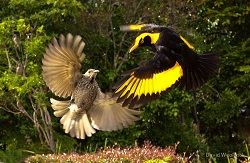
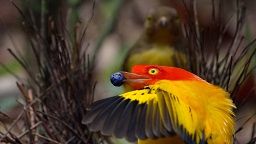
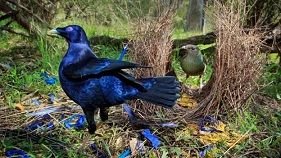
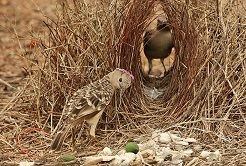
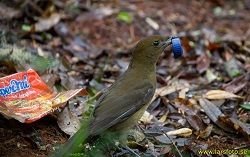
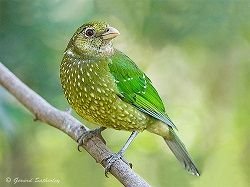
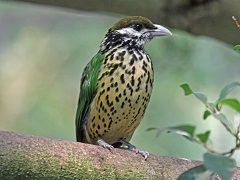
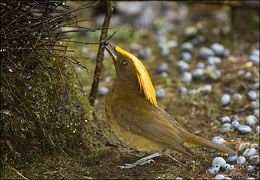
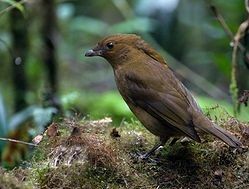

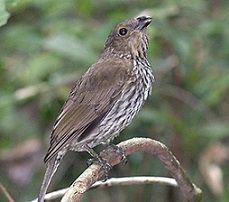

Really beautiful animals! I love how there's so much interesting diversity, can't wait to check out your other posts :)